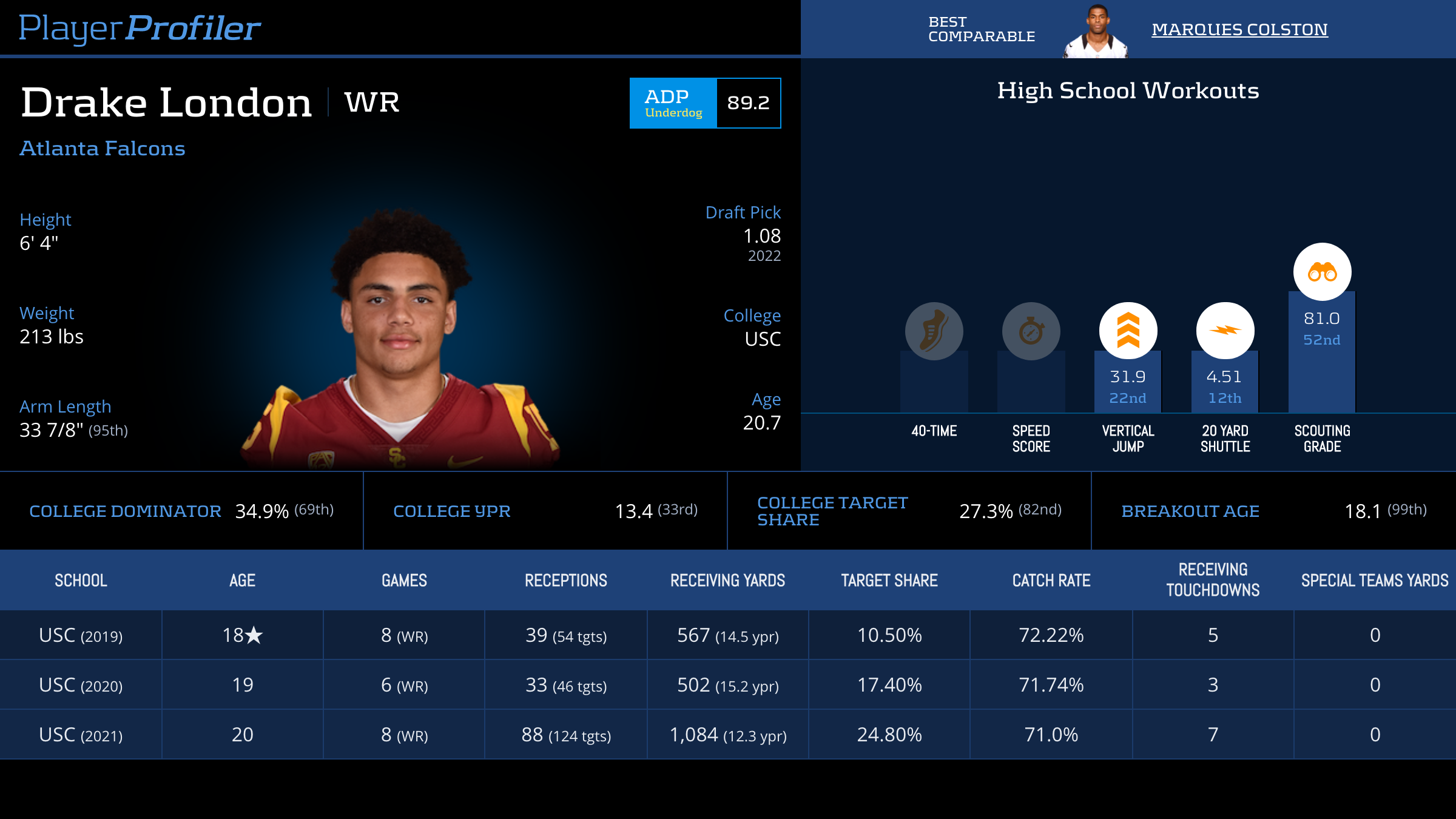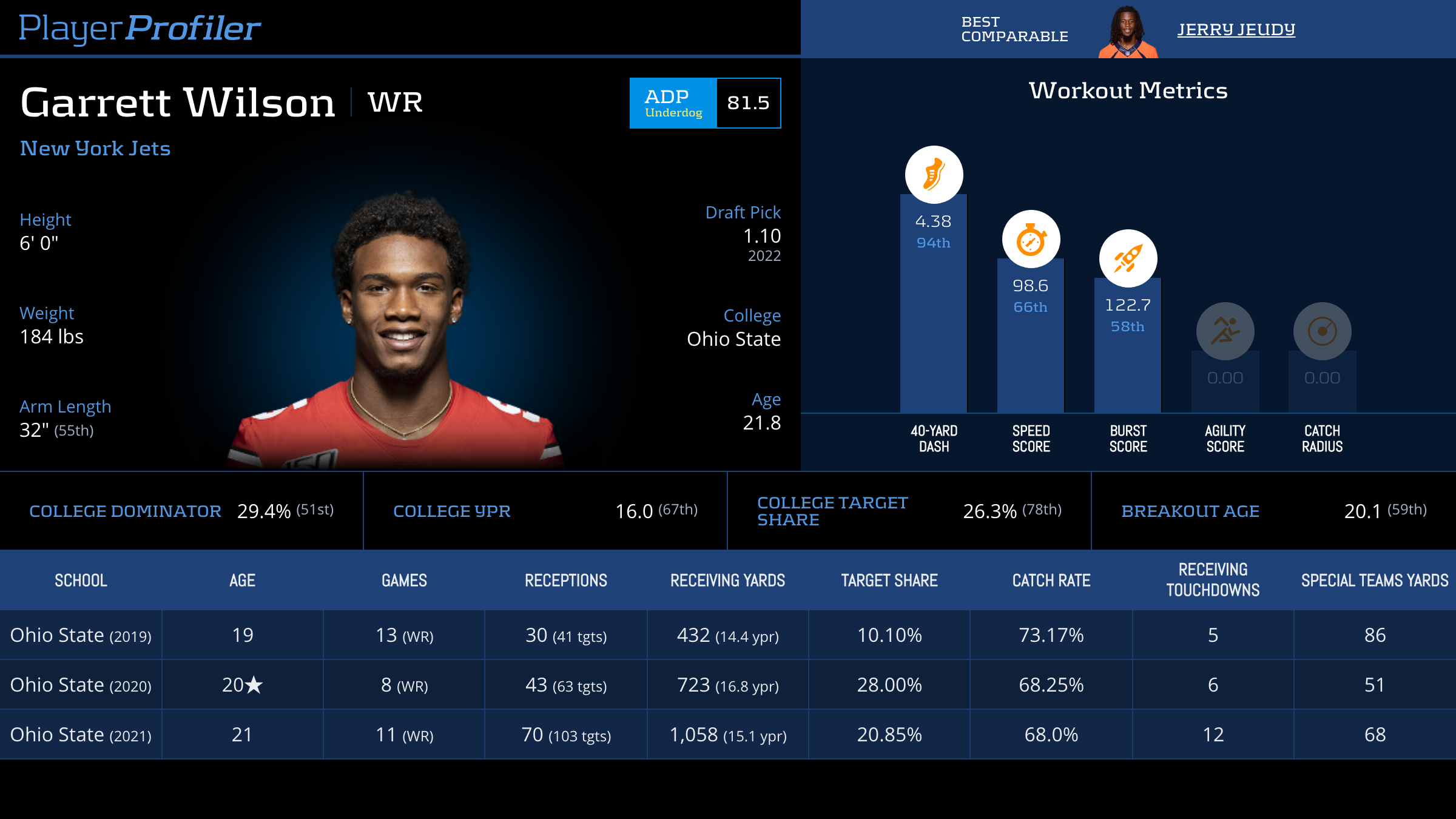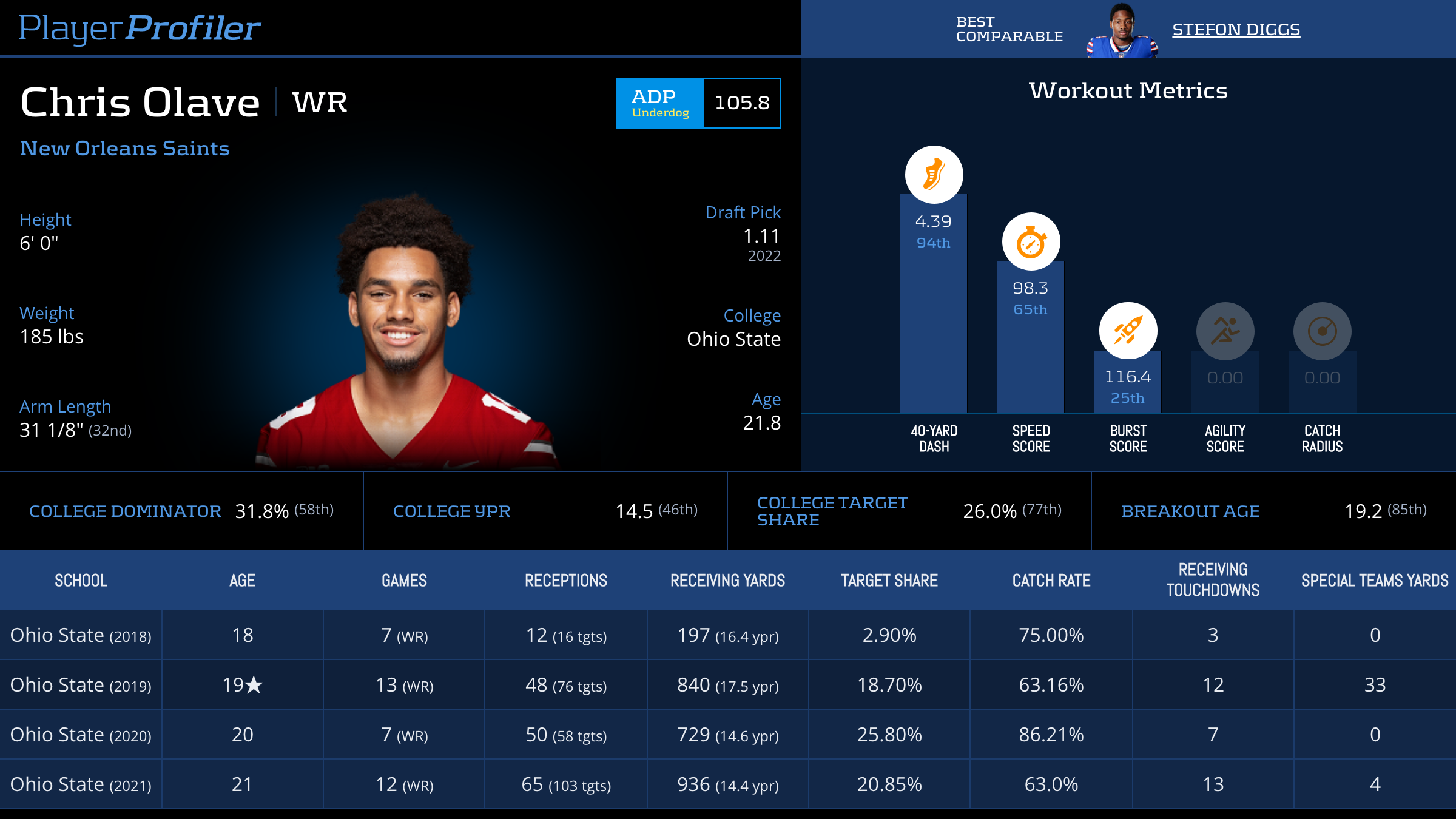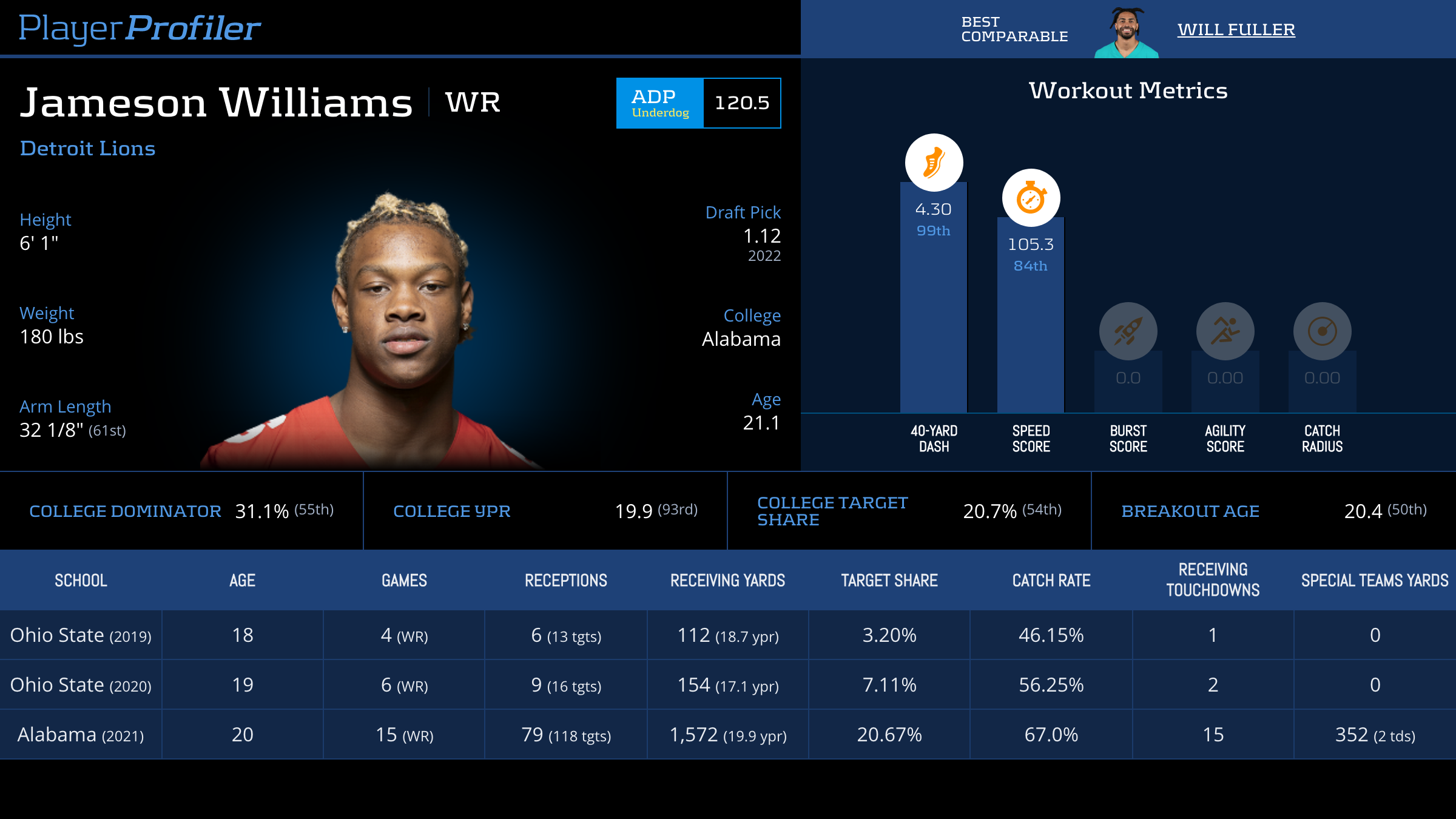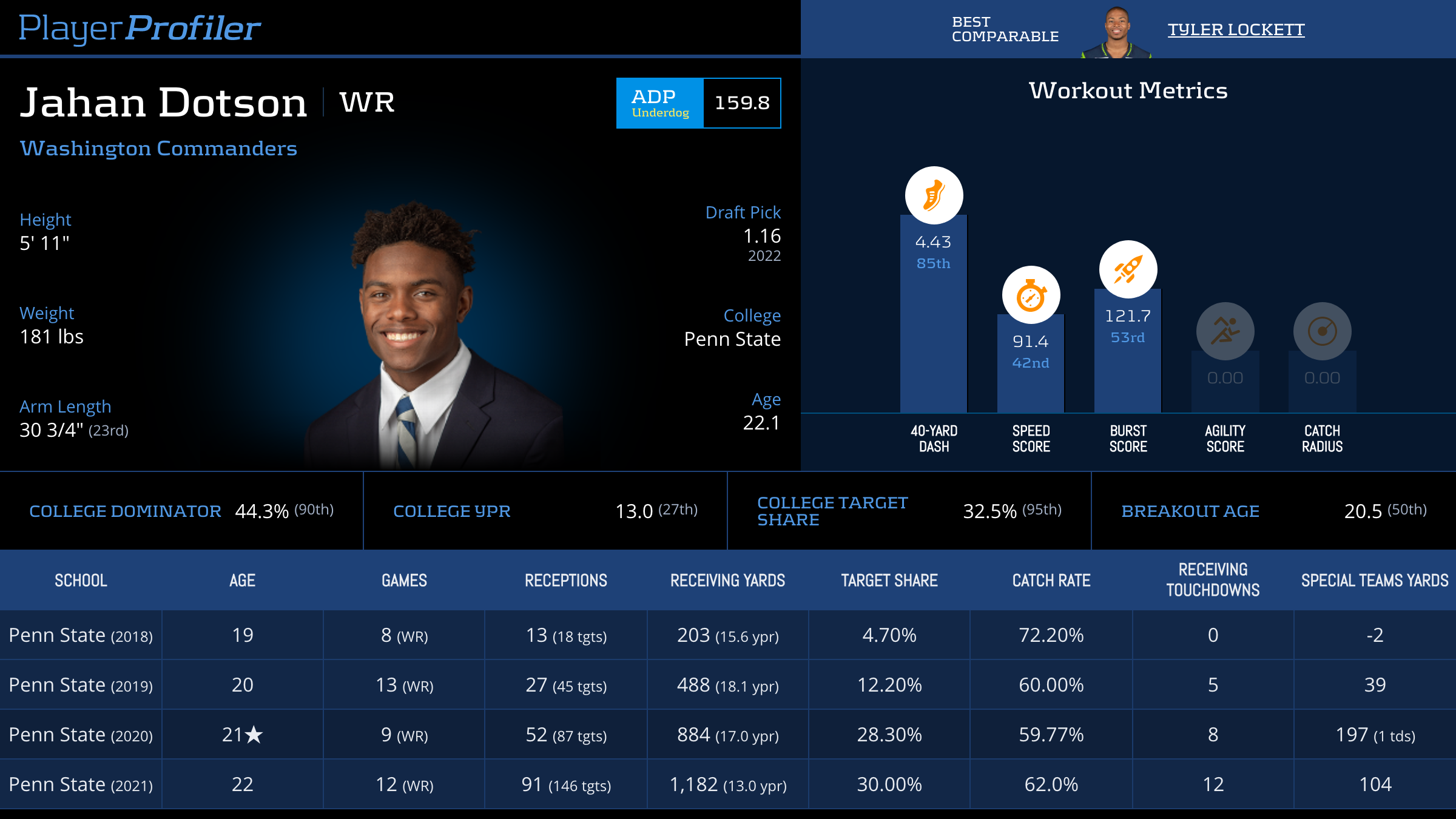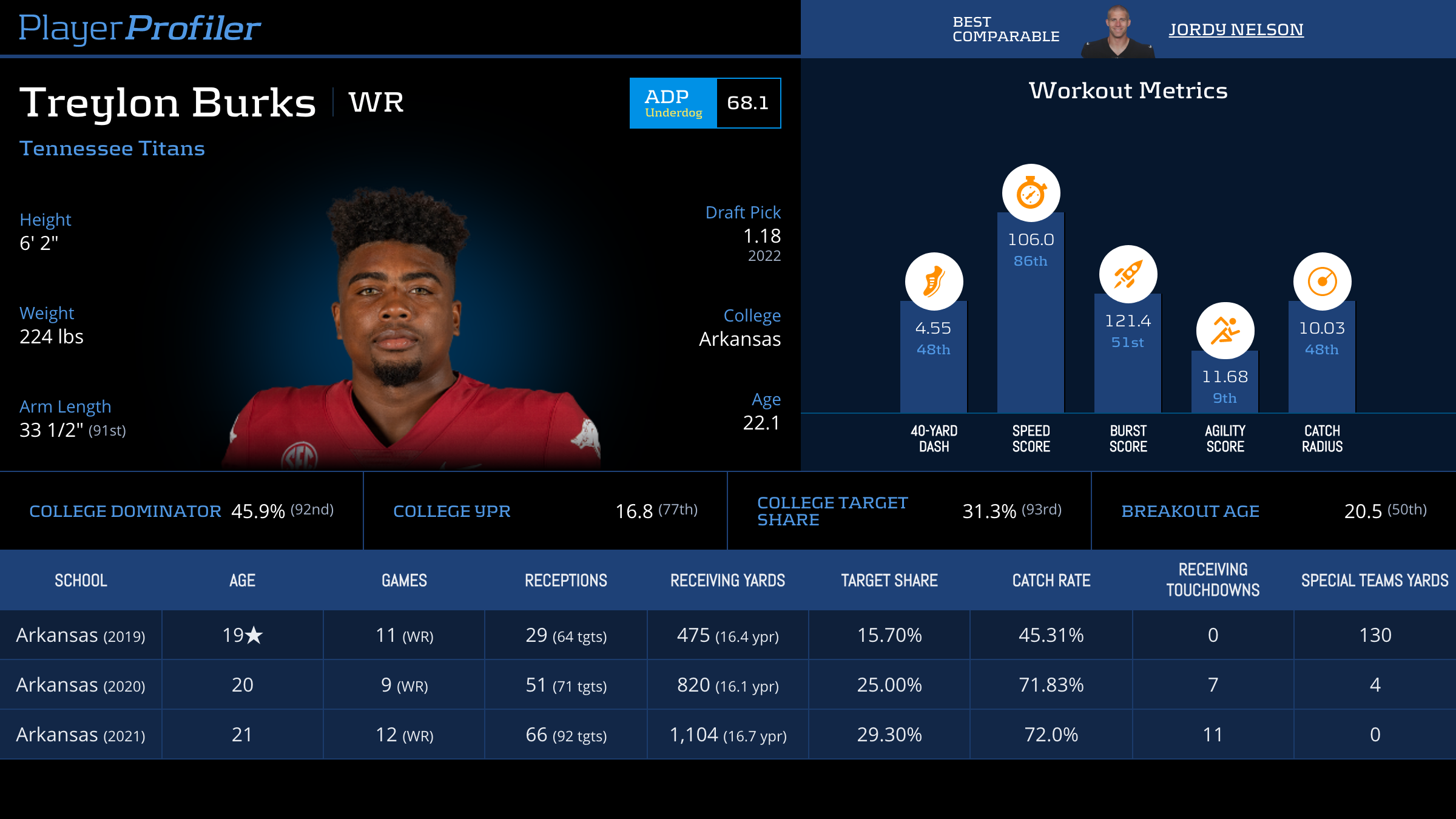The wide receiver market has been shifting the past few years, with rookies like Justin Jefferson and Ja’Marr Chase making huge impacts while veterans like A.J. Brown are dealt and paid. Teams are placing a premium on young wide receivers and this year’s draft saw six receivers selected in the first round. Only one receiver can be the rookie WR1, and first-round receivers have the strongest cases to achieve that. Here, I go over the case for each first round receiver to be the rookie WR1 … or if they even have one.
Drake London
The first receiver selected, Drake London, goes to Atlanta to play with Marcus Mariota and fellow rookie Desmond Ridder. London put up over 1,000 receiving yards on 88 receptions his last college season and had a 27.3-percent (82nd-percentile among qualified wide receivers) College Target Share.
London is a large target with 95th-percentile arm length, benefitting him for contested targets. He also boasts an 18.1 (99th-percentile) Breakout Age and 34.9 (69th-percentile) College Dominator Rating, a similar mix of Breakout Age and College Dominator Rating to Donte Moncrief, Sammy Watkins, and DeAndre Hopkins.
breakout ratings 16-20 all-time:
brandin cooks: 60.2
drake london:59.1
jordy nelson:58.0
ceedee kamb: 57.9
keenan allen: 57.9good company.
— the podfather™️ (@Fantasy_Mansion) May 11, 2022
Moncrief, Watkins, and Hopkins provide different levels to London’s potential, but his volume gives a strong rookie WR1 case. In Atlanta, Kyle Pitts and *maybe* Bryan Edwards will be the only threats to London’s volume. Mariota will take risks in a Falcons offense that will play from behind and has three big targets in Pitts, Edwards, and London to compete for contested targets. London is already the second target on a team that will see high passing volume with strong measurables that give him a case for rookie WR1. Atlanta’s QB situation will be the primary thing to hold him back.
Garrett Wilson
Going to the Jets, Garrett Wilson will be part of a growing receiving corps for Zach Wilson. Wilson was part of a talented Ohio State WR group, where he put up over 1,000 receiving yards last season. He ran a 4.38 (94th-percentile) 40-yard dash and brings agility to the field. Nothing particularly stands out as a top-of-class measurable for Wilson, but his separation and after-the-catch prowess give him Jerry Jeudy as PlayerProfiler’s Best Comparable. Wilson can offer separation like Jeudy and contested catch ability as the Jets’ new outside receiver.
Wilson will primarily compete with Elijah Moore and Corey Davis for targets in New York. He is a larger receiver than Moore and more agile than Davis, which will help him garner more targets. However, both Moore and Davis have their own merit and prior production in New York, each seeing at least an 18.0-percent Target Share last season. Taking targets from them immediately is not a given. Wilson was greatly productive competing for targets in a talented Ohio State group, but greater target competition and QB play could hamper him from being the rookie WR1.
Chris Olave
Picked right after his fellow Ohio State receiver, Chris Olave joins a fruitful receiving corps in New Orleans. Olave broke out early, with a 19.2 (85th-percentile) Breakout Age and his best college seasons in 2019-2020. He demonstrated good route running with speed with the Buckeyes, which will transfer well for the Saints. His combination of Breakout Age and 31.8-percent (58th-percentile) College Dominator Rating is similar to the Breakout Age and College Dominator Rating combinations of K.J. Hamler, Jamison Crowder, and Antonio Brown, giving Olave a productive floor.
The Saints added Jarvis Landry to Olave and Michael Thomas in Jameis Winston‘s receiving corps. Neither Thomas nor Landry have seen Target Shares below 20.0-percent since 2016, so it’s a near assumption that Olave will be the WR3. However, New Orleans trading up for him is a good sign that the team likes him to take on a formidable role, but it may not be this season. While he has the skills to earn rookie WR1 targets, he may be blocked by Landry and Thomas from getting the volume necessary to be the rookie WR1.
Jameson Williams
The Lions traded up for Jameson Williams, continuing a run on receivers in the middle of the first round. He really only has one year of college production, but it was a massive 1,572 receiving yard season at Alabama.
Williams had 19.9 (93rd-percentile) College Yards Per Reception, garnering those yards on a 20.7-percent (54th-percentile) College Target Share. He is a speedy deep threat with average size, best comparing to a Will Fuller-type player. Despite just one year of college production, he profiles to be Detroit’s long-term deep target.
#Lions coach Dan Campbell says WR Jameson Williams is at rookie minicamp, but isn’t going through physical drills. However, he is “very much engaged” as he continues to recover from his ACL injury.
— Eric Woodyard (@E_Woodyard) May 14, 2022
Williams will be competing with D.J. Chark, Amon-Ra St. Brown, and T.J. Hockenson mostly for targets. Detroit played with a negative Game Script most of last season, and that looks to be the same this season with Jared Goff still at QB. There will be plenty of pass volume, but Chark will eat up some of Goff’s low-volume deep targets. Williams is also recovering from an ACL injury, which could hamper his integration into the receiving corps. While he has chunk yardage ability, Goff’s lack of deep targets and Detroit’s sizeable target competition may make him more of a dynasty investment than the rookie WR1.
Jahan Dotson
The Commanders selecting Jahan Dotson at pick No. 16 felt like a reach given pre-draft buzz. However, Dotson was a productive college player with agility and the ability to play out of the slot.
Through four seasons at Penn State, Dotson achieved a 32.5-percent (95th-percentile) College Target Share and broke out with a 44.3-percent (90th-percentile) College Dominator Rating. His combination of College Dominator Rating and Breakout Age is similar to the combinations for Eric Decker, D’Wayne Eskridge, and Deebo Samuel, giving him different levels of versatile potential.
https://youtu.be/2LpQSbDYYdQ
In Washington, Dotson will compete with Terry McLaurin, Logan Thomas, Curtis Samuel, and more for targets from Carson Wentz. His ability to rotate inside to the slot should keep him on the field more often. His versatility and hands will earn him targets early on, propelling him to the team’s No. 2 option. While McLaurin is the definite target-eater in Washington, Dotson’s skills give him opportunity to be the rookie WR1. However, smaller length and likeliness to be a shallower target (especially with Wentz) could hamper that opportunity.
Treylon Burks
The Titans swapped out A.J. Brown for Treylon Burks during the draft, adding the Arkansas product to a team expected to contend.
Burks saw a 31.3-percent (93rd-percentile) College Target Share with back-to-back seasons of over 71.0-percent Catch Rates from 2020-2021. He has size, length, and speed, with a 91st-percentile arm length and 86th-percentile Speed Score. His PlayerProfiler Best Comparable is Jordy Nelson, another productive receiver with size. Burks profiles as a size mismatch who can fight for yardage and contested targets.
Treylon Burks is now my WR2
-Lack of confidence that Zach Wilson takes the next step
-Elijah Moore's elite stretch during his rookie season
-Burks "replacing" AJ Brown (his ceiling comp)
-Breece Hall signals NYJ probably run/pass balanced
-Henry is 28 and Tannehill is still good— Josh Larky (@jlarkytweets) May 2, 2022
In Tennessee, Burks’ only major threat for targets is Robert Woods. With his draft capital, physicality, and versatility, he is a prime target for Ryan Tannehill. The Titans are looking for a new physical WR1, and with Woods getting older, Burks is next up. However, Tennessee played with a positive Game Script (No. 11 in the league) last season, leading to a 31.5 (No. 25) Team Pass Plays Per Game average. With Derrick Henry in the backfield, Burks may not see as much pass volume as guys like London or Williams. Still, Burks has a physical profile and clear path to being the WR1 on his own team, giving him a strong case to be the rookie WR1.
Verdict
Each of the six first-round WRs have cases to be the rookie WR1, but some cases are better than others. Chris Olave and Jameson Williams face strong target competition in their landing spots, while Jahan Dotson isn’t on the same level in terms of measurables as the other first round WRs. Garrett Wilson also faces strong target competition but has more skill to overcome that competition. Drake London and Treylon Burks both have paths to being the WR1s on their own teams, and are ranked No. 1 and No. 2, respectively, on PlayerProfiler’s rookie WR rankings. London and Burks have the strongest cases to be the rookie WR1, with minimal target competition and physical profiles. QB play for London and Game Script for Burks are the only obstacles in the way. Look for value in these two in rookie drafts.

